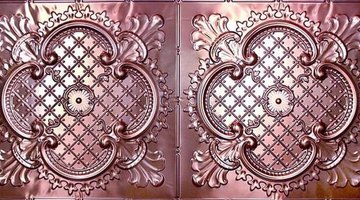How to Restore Antique Ceiling Tin
If you buy a Victorian house or an old hotel that was built in the 1800s, you may find you are the proud owner of antique tin ceilings. Why not restore them to their original beauty? You may be removing old lead paint at the same time, so this process requires many protective measures due to toxicity and safety issues.

Things You Will Need
- Sand blaster or heat gun
- Plastic sheets and tape
- Plastic smock or cover
- Gloves
- Booties
- Mask
- Ladder
- Steel wool
- Primer
- Metallic spray paint, or oil based paint
-
Prepare the room. Tape up double thicknesses of plastic sheeting stretching from the top of walls down to floors. Cover the floors and tape at the baseboards. Make sure any fixtures or furnishings are covered. Tape the sheets together to make seams. Leave a small slit for entry and exit. In essence, you'll be making a "plastic room." If you're not dealing with toxic lead paint, you just need to sheet enough for easy clean-up from falling paint chips. .
-
Wear protective gear including gloves, a mask, a hood to cover your hair, a smock and booties. After use, do not wear this gear into the rest of the house; take it off and put it on right outside the slit in the plastic.
-
Set up ladder, and position yourself to sand blast the paint off the ceiling tiles. You'll need a high-powered sander or abrasive pad attached to a high-powered drill, especially if there are multiple paint layers. It's just like sanding any other paint off, but don't go so far you damage or dent the tin. For only one or two layers of paint, some experts say you may be able to use a heat gun to get the paint off, which is easier on the tin and may allow some of the metallic finish to remain; this is sort of like using a hair dryer on steroids.
-
Ask at the hardware store for a good rust remover. "Naval Jelly' is one that is like a paste you apply and wipe off. Next, you can buff the tins with steel wool, or use a buffing attachment on your high power drill. This may remove some of the patina of the aged tin, but will get rid of any remaining paint, and create a smooth surface.
-
Paint the ceiling tins. Use a primer first, and then you can restore the antique ceiling tin with a metallic spray paint, or a semigloss oil-based paint. Latex paint is water-based and can cause rust. To finish the tin with an interesting antique silver look, spray primed parts with silver metallic spray paint and then mist with Rustoleum Black Enamel spray paint from a distance of 12 inches. For antique copper, use bright copper spray paint first, and then mist with black enamel. For antique gold, use bright metallic gold paint with a faint black enamel mist (see Resources below).
Tip
Sand blasting can beat the tin up, and even soda blasting removes shine. You don't have to be too particular if you're going to cover the tin with with semigloss paint or metallic spray. The results will be spectacular. Blasting tins with dry ice makes them shiny and beautiful and may allow you to keep the original finish, but it is more time consuming and expensive. You might want to try this for smaller projects. If you are sure you're not dealing with lead paint, perhaps because the previous owners provided proof that lead paint is not an issue, you can ignore some of the protective measures. If some tins are damaged, you may be able to buy replacement ceiling tins that are close reproductions or identical to the originals.
Warning
Clean up and disposal of the gear worn and the plastic sheeting should be done carefully. The lead dust is toxic.
Resources
Tips
- Sand blasting can beat the tin up, and even soda blasting removes shine. You don't have to be too particular if you're going to cover the tin with with semigloss paint or metallic spray. The results will be spectacular. Blasting tins with dry ice makes them shiny and beautiful and may allow you to keep the original finish, but it is more time consuming and expensive. You might want to try this for smaller projects. If you are sure you're not dealing with lead paint, perhaps because the previous owners provided proof that lead paint is not an issue, you can ignore some of the protective measures. If some tins are damaged, you may be able to buy replacement ceiling tins that are close reproductions or identical to the originals.
Warnings
- Clean up and disposal of the gear worn and the plastic sheeting should be done carefully. The lead dust is toxic.
Writer Bio
Linda Johnson is a veteran writer and Photoshop and Illustrator aficionado. She is a TV-radio producer, ad agency owner and a winner of Addy Awards and the First Place Award for Best National Public Service Film. In addition to Johnson's online work, her writing has appeared in "Poetry Guide," the "Indianapolis Star" and Indianapolis Dine magazine.
More Articles



